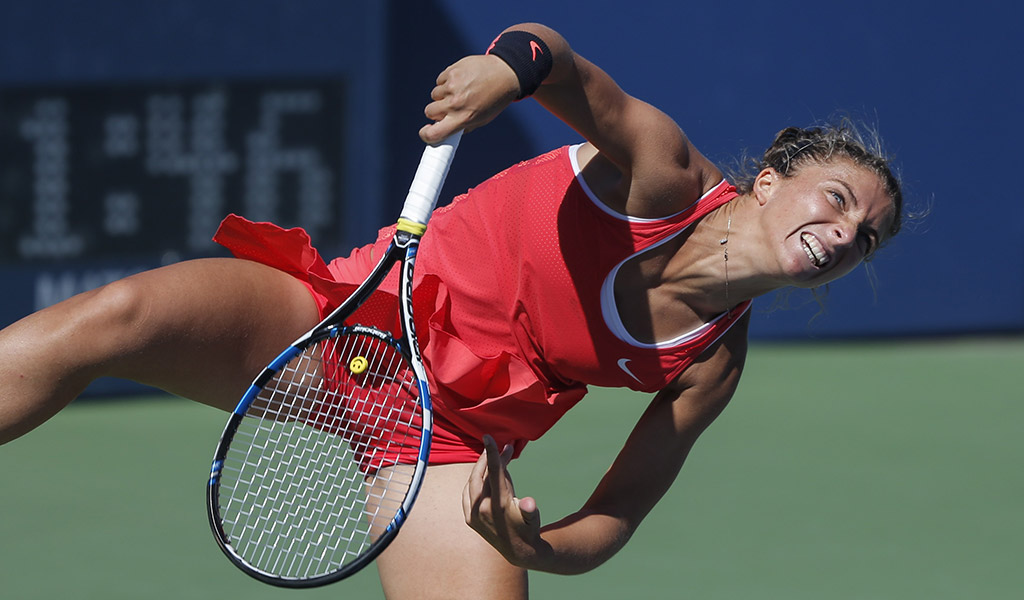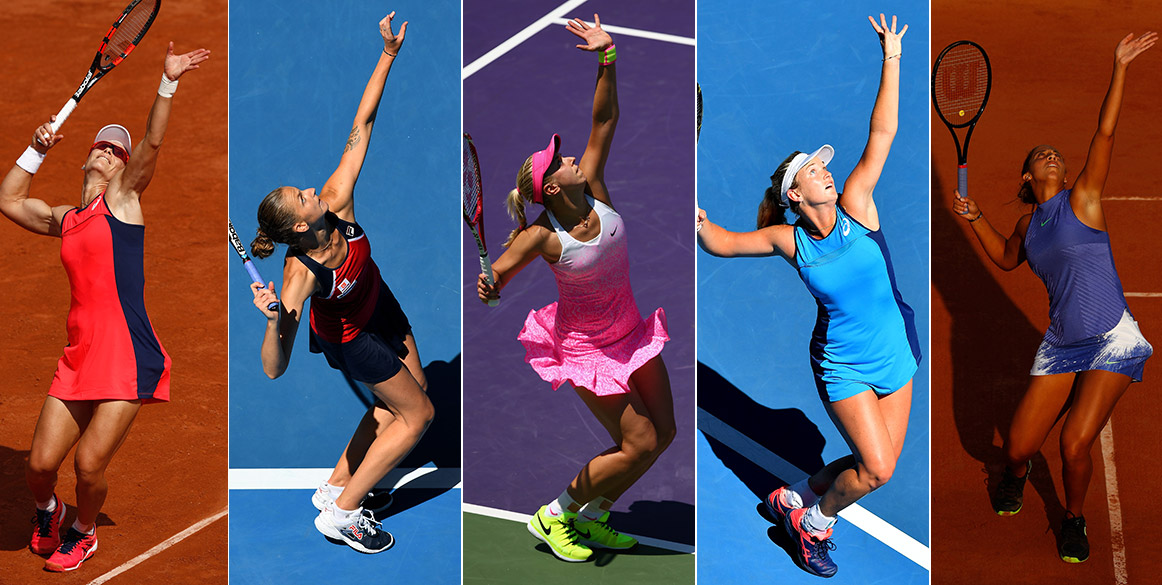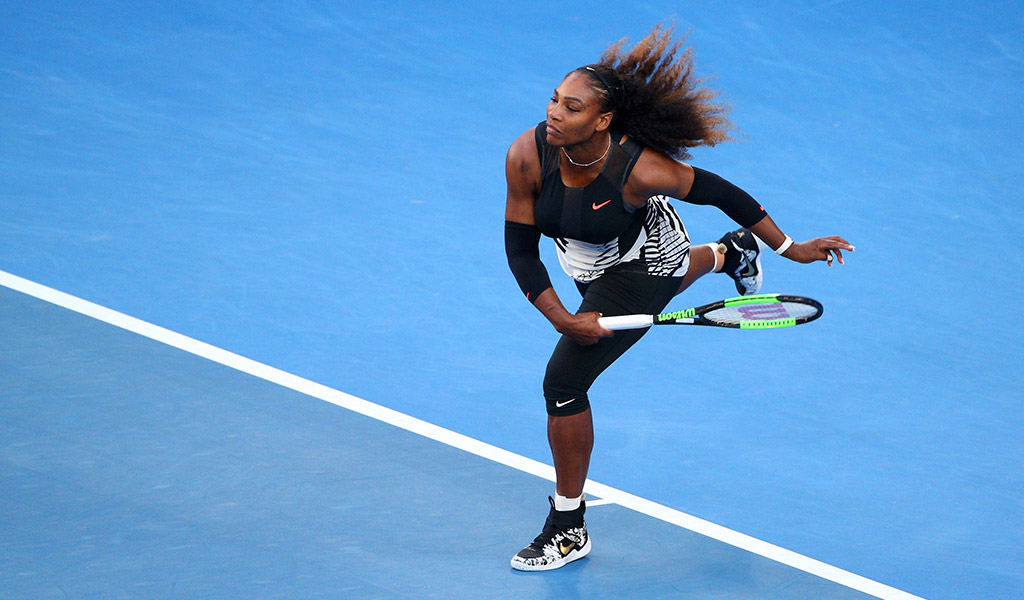Alicia Molik, a former top 10 star who owned one of the sport’s best serves, believes service “yips” are a more common phenomenon in the women’s game than the men’s.
Australian tennis coach and researcher Dr Machar Reid says, biomechanically speaking, athletes need to have their whole body working for them in moments of stress. “Any individual who doesn’t have that (happening) is going to be exposed,” he says.
Biomechanical flaws. A breakdown in technique. Double faults. The examples over the years are plentiful. Anna Kournikova. Elena Dementieva. Ana Ivanovic. Camila Giorgi.
Double faults aren’t the only indicator of a hitchy, glitchy delivery. Former world No.5 Sara Errani frequently attains a first-serve percentage above 80 per cent yet averaged a first-serve speed of just 116km/h in her opening-round wins at this year’s Australian and French Opens.
Observed Canadian journalist Stephanie Myles: “It’s a tremendous tribute to Errani that she has had such a great career – with a hot mess of a serve that defies description, and logic. While the veteran Italian is definitely height-impaired in terms of getting the trajectory taller players enjoy, there have been plenty of short players throughout the history of tennis who had very good serves. And Lord knows there is plenty of poor serving technique on the women’s side of the game these days – inexplicably, since it’s pretty easy to calculate the benefits of having a good one.”

Sara Errani serving; Getty Images
She’s right. Short stature didn’t rob Justine Henin, or later Simona Halep, of serving ability. And it’s even more surprising that players such as Dementieva and Ivanovic – tall, athletic, strong and powerful – could struggle so much with their own deliveries. Even Venus Williams, considered one of the better servers in women’s tennis, possesses technical flaws. According to Reid, Williams “opens up way too much (and) relies on specific body parts to the detriment of others”, especially on the second serve. “She’s far more likely to have an action that suffers when things get tight,” he says.
Why do serving problems persist in the women’s game? Why is the serve so often considered a point of weakness, an area ripe for attack?
Todd Woodbridge believes old habits die hard. “(Players) have to learn how to serve and get the ball in the court to start the point from the age of, say, 10. The easiest way to do that is to throw the ball up and wrap your arm and racquet head around the ball and slice it into the court,” says the 22-time Grand Slam doubles champion. “Over the period of development for young women, they never get out of that action. They have no shape on their serve, and an inability to get the ball into the corners as well as a male can with heavy kick or shape.
WOODBRIDGE: Barty’s extraordinary return
“When an opportunity arises to continue to work on their technique, (women) still think, ‘I’ll get it in and I’ll keep winning with what I’ve got’.”
Woodbridge points out that young boys experience a similar situation to girls when they first learn to serve, but that this barrier is overcome through the development of physical strength. “At around about age 12 to 14 their bodies change enormously. They start to get strength and power and are able to adapt a lot quicker than a young female at that age,” he says. “Even though girls mature earlier, they don’t really get super strong until they’re 18, 19, or 20.”
By then it’s often too late to change much in the way of technique. But Woodbridge’s point is of course a generalised one. There are many women – Serena Williams, Karolina and Kristyna Pliskova, Sam Stosur, CoCo Vandeweghe, Madison Keys, Sabine Lisicki – who own explosive, versatile, technically-sound serves. Molik was another, a player who rose to world No.8 in 2005 with a serve that regularly generated double-digit ace tallies in matches. “There’s no question – my serve gave me a career,” she says.

(L-R) Sam Stosur, Karolina Pliskova, Sabine Lisicki, CoCo Vandeweghe and Madison Keys are among the premier servers on the women’s tour; Getty Images
Molik’s experience in developing the stroke was completely different to the one Woodbridge describes.
“I had a great local coach (Kevin Swanson) who was fantastic technically. He was almost my model … when I had my private lessons it’s what I would try and mimic. So I think from the get-go I was taught quite good fundamentals,” she explains.
“It was something that I would practise a lot. I would often go out and and serve for an hour-and-a-half at a time as a kid. My parents didn’t play a lot of tennis so that was something I could do alone at the tennis club – all I needed was a bucket of balls and a few empty cans (as targets).
“I think what helped me too was I grew up playing a range of sports. I probably threw as many balls as I served, just in games at the park or in the back yard with my brother. And there’s no question the sling-shot action of throwing a ball is almost identical to a serve. You develop a loose arm, wrist-snap, the coil with your trunk, being side on, using your legs, using your base. That really transferred to my tennis.”
In data presented at the Biomechanics in Sport Symposia in 2013, Dr Reid – now Innovation Catalyst at Tennis Australia – was among a group of researchers working to answer two questions: how did the female serve compare to the male serve, and how stable was the female serve across time?
RELATED: Serena gets technical, discusses game
Using 3D motion analysis to assess the serves of Australian players Sam Stosur, Ash Barty (then aged 15) and Seone Mendez (then aged 11), Reid’s team found that the serves of elite female players were relatively similar to their male counterparts – male data was collated from studies that already existed – in areas such as knee flexion and extension, vertical hip drive, trunk tilt, elbow extension, wrist flexion and impact point. Statistically significant differences were found in trunk rotation, racquet and ball velocity and spin imparted on the ball; all were found to be greater in males.
Reid explains that, in many cases, females don’t engage parts of the body to their full capacity, affecting other biomechanical elements further down the chain.
“One of the things that we observe in the female versus the male serve is that internal rotation – or the speed of that, with regard to the shoulder and upper arm – is discernibly different. But that ties in with the use of the legs, and the use of the trunk,” he says.
“With females, you often see deficits at the level of the legs – they might get down as low as a male, but they don’t generally come out anywhere near as quickly. There’s also a relationship with how the trunk rotates and the position of the ball toss. Coaches talk about the old clock-face; a lot of the girls will hit off one o’clock, versus most of the males – or where you actually want to be contacting the ball – at around 11:30. That (11:30 position) helps with how they rotate the trunk; it allows them to contact the ball higher, so they get more height over the net and also engage internal rotation to better effect.
“So if females are not using their legs particularly well and they’ve got their ball toss in the wrong spot, they’re not going to get as much out of their shoulder. One of the most simple interventions for girls – assuming they’re strong enough – is to shift their ball toss to a better place. And that’s more leftward for a right-hander (and vice versa).”
Stosur was clearly strong enough; according to Reid, her serve “stacks up pretty well” when compared with an exemplar male serve.
Interestingly, with the forehand generally regarded as the weaker shot in the women’s game, a ball-toss closer to one o’clock for right-handers – making it easier to serve out wide to the forehand – could actually be advantageous. “What females might want to tactically achieve out of their serve might be slightly different, so that might shape their action,” Reid notes.
Yet the issue of strength, and whether females have enough to be taught technique more prevalent in the male game, is something clouded by long-held perceptions.
Woodbridge says that when he first started playing tennis as a child, he served with an Eastern forehand grip because he couldn’t manage a Continental grip. As he began showing promise as a junior, he was told he couldn’t get away with that, and worked to remodel his serve accordingly.
PERFORMANCE: how to master the kick serve
Why weren’t similar conversations happening between coaches and female juniors to correct similarly-flawed technique? “Good question,” Woodbridge replies.
Reid says coaches must make a decision – regardless of whether they’re working with a male or female player – to introduce the kick serve. He said that while this typically occured around age 12, there was often a reluctance to start teaching it to girls at this age, putting them behind the biomechanical eight ball. “By not introducing a kick-serve at that age, that begins to challenge a player’s coordination, because it doesn’t expose them to a particular body shape and action that they might want to become familiar with further down the line,” Reid explains.
“That’s where it becomes really important to treat every athlete on his or her merits; there’s no compelling or overarching scientific evidence to suggest that girls can’t perform kick serves at that age. I think as long as you’re introducing them as appropriate, it’s something that you want to do.
“I’m not saying it’s necessarily easy but I definitely think that we’re a little more fixed in our approach and perhaps influenced by what we see on television or how we think the game should be played versus developing more rounded players. We’ve got these biases that probably shape our thinking when we look at the female game versus the male game. That begins to shape our approach in how we develop female players from a young age.”

Serena Williams serving; Getty Images
Young girls picking up the game – and the coaches who guide them – already have an exemplary model to look to.
Serena Williams won her first major title in 1999 and ascended to No.1 in 2002. Almost 20 years on, in May 2017, she was still the world No.1 and a reigning Grand Slam champion. Her serve, widely regarded as the best in the history of women’s tennis, has been the bedrock of her success.
Surely aspiring female juniors were looking to emulate this, as best they could? “That’s how I would be coaching a young player,” Molik says.
“She’s dynamic, she’s powerful, she’s probably the best server in the world in women’s tennis. The amount of times over her 15- to 20-year career she’s been able to condense points because of an ace or an unretunrable serve – think about the amount of impact that takes away from her body in terms of having to rally, run, move and spend time on court?
“In big moments, she’s been able to crush so many opponents through a big serve whereas others have to work so hard. And when you’re a great server, mentally you have the advantage knowing you can shorten the point. You can serve an ace if you really want to.”
Molik, Woodbridge and Reid all identify Vandeweghe as a female player coming up behind Serena with an excellent serve in her arsenal. Yet she and players like her remain exceptions in the women’s game.
Until more coaches see the merits in developing young female players to their full capacity and potential, service yips are bound to persist.